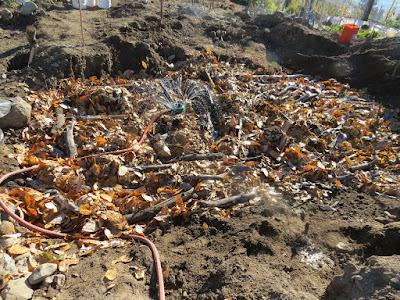One thing I really love about having a rotting wood garden is watching mushrooms pop up everywhere. And I do mean, everywhere! The first six of these photos are from last fall, but the rest are from the last few weeks.
Puff! Out of nowhere, they rise up.
I've used a lot of wood chips on the surface of the garden, mainly for paths. It turns out that wood chips make the fungi very happy, in addition to all the wood rotting beneath the surface. For a visual on what's below the surface, use the blog menu to check out the bed construction pages.
I found these shaggy mane mushrooms near where I had layered tamarack (larch) needles for weed control and to keep moisture in the soil. The property where the larch needles originated supports shaggy mane, so I'm thinking we may have transferred some spores with the duff. The shaggy manes really made me smile!
Inside the cambered frame, these smurfy looking mushrooms rose up...
among the Tiny Tim tomatoes (last summer).
A common place to find mushrooms is along the edges of my cold frames, where the wood chips meet the frames.
On to this spring, which has brought mushrooms at every turn. It amazes me how the earth gives way to these fruiting bodies...
...and how they can rise up even smack-dab in the middle of a dense clump of chives.
They can push through thick layers of leaves.
Here is a close-up from the above patch.
I'm going to need to learn more about identifying mushrooms!
These guys came up where the edge of the tipi greenhouse meets the path...
...and these ones in an asparagus bed, over the past couple of days.
BUT: the biggest surprise of all came at the edge of an area where I had sheet mulched over St. John's Wort, just outside of the garden.
It was dusk, and at first I thought I was looking at a strange kind of scat. I bent over and realized that the sheet mulched area was lined with morels! Here you can see a cotton sheet over some decaying cardboard... and then just a few inches out are morels.
I brought them home and cut them open, and sure enough they were hollow -- the real deal!
Paired with wild asparagus, it doesn't get much yummier.
At first I dried some in the dehydrator...
...but then I learned to dry them on newspaper instead. This way I can use the newspaper in future sheet mulching, and inoculate new areas with the spores. :-) Spreading the joy around, mycelium magic... What started off as weed control for St. John's Wort has grown into a way to raise edible mushrooms. Stacking functions!


















































